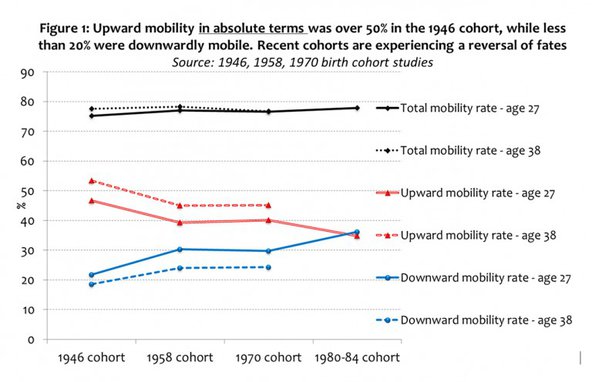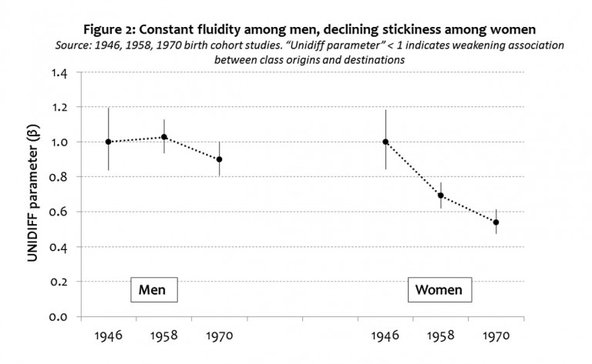Can we ever return to the Golden Age of social mobility?
by Dr Lindsay Richards
15 Mar 2016
To answer this question, we first need to explain what is meant by the term social mobility and how it is measured. Intergenerational mobility is a measure of the relationship between some measure of life success or status of a given individual compared to that of their parents. There is bound to be some debate about what people consider to be most important outcome to measure, but social scientists tend to focus on objective measures of socio-economic status. Here, I will be talking about social class, which is a measure based on occupation: at the top the higher professional and managerial positions (e.g. barristers, dentists) and at the bottom the routine or semi-routine occupations (e.g. shop assistants, bus drivers).
Why does social class matter so much? While class is not a direct measure of wealth or income, it is in fact an accurate proxy for long-term economic circumstances. Those at the top of the class structure generally earn more but also experience greater stability of incomes, lower risks of unemployment, and more chances for promotion than those at the bottom. (Social class also represents a hierarchical ladder of prestige and respect. In reality, processes of the allocation of economic resources and prestige are likely to be intertwined).

It is little wonder that we think of the post-war era as a ‘Golden Age’: based on a study of a cohort of individuals born in 1946 and ‘followed’ into adulthood, analysis of social class in 1986 (when the study participants were 38) reveals that more than 50% had ended up in a higher social class than their fathers, i.e. had been ‘upwardly mobile’. This is compared to just 20% in classes lower than their fathers, i.e. ‘downwardly mobile’ (see Figure 1). But are such figures a testament to the fairness of British society? This upward mobility undoubtedly had positive effects on the lives of those benefitting but this extraordinary mobility occurred at a time of extraordinary change to the occupational class structure. In 1951, 55% of the male workforce was working class and 11% were in professional and managerial occupations. By 2011, 30% are working class and 40% in the higher classes. The huge level of upward mobility, then, largely reflects that there was ‘more room at the top’ – there were simply more jobs to be upwardly mobile into.
More recent cohorts have experienced a rise in downward mobility, a finding that raises concerns in policy circles and among parents wanting the best for their children. Again, from the perspective of the experience of the individuals, downward mobility is certainly not good news and may be accompanied by psychological costs as well as economic ones. However, like our patterns of upward mobility in the 1950s, the increases in downward mobility may say less about fairness and more about the changing class structure: downward mobility has become more common because so many are now starting out from an advantaged position, just as in the 1950s so many started out from the working class.
Looking at these absolute rates of mobility therefore does not quite tell us what we need to know about the fairness of British society. To understand fairness we are more interested in quantifying the degree to which class background may prevent individuals from fulfilling their potential, or in the opposite scenario where those from advantaged backgrounds are (unfairly?) protected from downward mobility. Thus, social scientists depend on a relative measure of mobility which captures the relative chances of, say, ending up in a higher professional job and avoiding routine jobs for those starting out with professional parents versus those starting out with working class parents. And here the figures are stark: men born to professional parents are about six times as likely to end up in professional/ managerial rather than routine occupations as those with working class parents. The figure is about five times for women. As if any of us ever really doubted it, class still clearly matters in Britain.
Education is often held up as the solution to the mobility problem. The idea is that individuals from disadvantaged backgrounds can do well at school and university and work their way into higher class positions by a process of “meritocracy”. Superficially this might sound like a good idea, but it is one that doesn’t hold up well in practice. Availability of graduate jobs (if such a concept still exists) has not kept pace with the increasing supply of university-educated young people entering the labour market, and in relative terms the value of getting a degree may be declining. While it is true that those from disadvantaged backgrounds have good chances of getting the higher class jobs if they get good qualifications, such a group remains small in number and is more than offset by advantaged individualswithout good qualifications but who are somehow enabled by their backgrounds to do well (also see, for example, table 3 in this paper).

Statistical analyses of the relative rates of mobility over time (a technique effectively ‘removing’ the confusing effects of changing class structure) show a pattern of relative constancy going back to the post-war period for men (see Figure 2). Women in full-time employment experience the same constancy as men, although mobility may be increasing for women who work part time. This is not the positive picture suggested by changes in absolute mobility in the Golden Age, but nor is it the gloomy conclusion that class mobility has ground to a halt. Coming back to the original question: can we get back to a Golden Age of social mobility? It seems unlikely. Moreover, in relative terms, there never was a Golden Age. The story of class advantage in Britain is one of persistent, rather than worsening, inequalities, though with a possible chink of light suggesting some improvement.
Dr Lindsay Richards is a postdoctoral research fellow at Nuffield College. This blog post is largely based on Professor Goldthorpe’s notes, summing up years of research, and kindly provided in advance of his lecture later today at the British Academy, the first in a series of sociology lectures for the general public. The hard evidence is published in a CSI briefing note, accompanied by a report of new research findings by Professors Heath and Li on the interplay of class and ethnicity – which matters more? Find out here.


